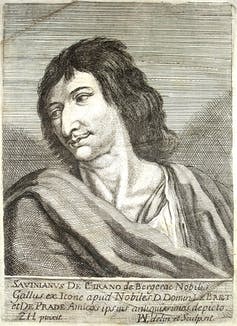Beyond Cyrano de Bergerac's nose – the real man behind the swashbuckling hero

There’s something quite striking missing in Peter Dinklage’s performance of Cyrano de Bergerac. In the upcoming musical film, Cyrano is missing his iconic large nose.
Cyrano’s nose has been integral to popular images of the character ever since Edmond Rostand’s swashbuckling 1897 verse drama Cyrano de Bergerac. This connection became even more so after Gérard Depardieu’s take on the role in 1990.
In every iteration of Cyrano’s tale till now, his large nose causes him trouble and affects how people perceive him. In the new film, Dinklage’s form of dwarfism, called achondroplasia, as one critic wrote, “serves the same purpose the character’s oversize schnoz originally did, lending Cyrano an outsider quality that he must overcompensate for in personality”.
Cyrano is a witty wordsmith and staggeringly proficient swordsman, able to defeat his opponents with both verbal and physical deftness. For instance, in one scene in the Depardieu film, Cyrano duels and vanquishes a vicomte who insults his nose. He does this while improvising an elaborately complex poem called a ballade.
Despite such prowess, his looks limit him. Secretly in love with his dazzling cousin Roxane, Cyrano is held back by shame at his physical appearance. He can only find selfless, vicarious satisfaction by feeding lines of passionate poetry to his rival-cum-alter-ego, the handsome but ineloquent hero Christian, who wins Roxane’s heart.
In each new retelling of the story of Cyrano we see the fragile romantic hero tormented by his own perceived lack – it is easy to forget that another Cyrano lurked still further in the background: the real-life playwright, satirist, novelist, and duellist Savinien Cyrano de Bergerac (1619-55). Because of his taste for bluster and grandiose self-mythologisation, we know relatively little for certain about the historical Cyrano.
A colourful life
As a young man, the real Cyrano was taught by the idiosyncratic polymath Pierre Gassendi and mixed in free-thinking “libertine” circles. He was known to spend time with writers such as Paul Scarron and Tristan l’Hermite. It’s even believed that perhaps at the fringes of these circles was the great comic playwright Molière.
In his short life, Cyrano proved himself to be a talented and adaptable writer. He never settled down to one genre for long (tragedy, comedy, letters, fiction and more) but maintained a strong intellectually satirical vein throughout. The impressive verbal ingenuity we see in Rostand’s play is also reflected in Cyrano’s various writings, perhaps most cruelly in his witty fat-shaming of the actor known as Montfleury.
A would-be astronaut
The real Cyrano was very adept at self-construction and even self-mythologisation. As a young soldier, he fostered rumours that he had routed 100 attackers at once. He claimed some symbolic kinship to classical heroes and warriors by styling himself “Hercule” de Bergerac. Unsurprisingly, both these elements find their way into Rostand’s play.
While the persona Cyrano adopts for himself as protagonist and narrator of his philosophical novel L’Autre monde is somewhat more modest and cryptic (the name of its hero “Dyrcona”, a near-anagram for Cyrano). The first-person, pseudo-autobiographical fiction he spins here is even more outlandish. In this tale of adventure and daring, he claims to have travelled through outer space to visit the Moon and the Sun and to have conversed with the curious inhabitants of both.
As well as inspiring a scene in Rostand’s play, the novel also anticipates the various philosophical travel narratives of Montesquieu, Jonathan Swift, and Voltaire in the following century. Indeed, Dyrcona’s discussions with his various otherworldly interlocutors cover a range of theological, scientific, political, philosophical, and “libertine” topics – from theories of atomism to biblical accuracy, from cannibalistic orgies to the existence of God. Knowing that the text was philosophically and theologically contentious, he did not publish the work during his lifetime. It was published in a heavily sanitised version entitled Histoire comique (Comical Story) in 1657.

L’Autre monde remains Cyrano’s most popular work and has various quirks to interest the modern reader. Among other things, the novel anticipates caravans (some moon-dwellers own mobile houses) and audiobooks (small boxes which read chapters out loud). Some of Cyrano’s other fabrications are rather more fantastic: hunting weapons that simultaneously cook the game they shoot, intercontinental flight with the help of bottles of evaporating dew, musical communication, and poetry as a means of currency.
One of the most suggestive moments of the novel for many comes when the moon-dwellers explain how a large nose is the marker of someone “spiritual, courtly, affable, noble-minded, [and] liberal”. This leads us back to Cyrano’s actual nose: was it purely Rostand’s invention? Yes and no. Contemporary illustrations of Cyrano show him to be relatively well-endowed nasally but never quite reaching the grotesque extremes we find in Rostand. Even so, in his overall encapsulation of Cyrano’s swagger, ebullience, and creative verve, it is fair to say that Rostand’s depiction was very much on the nose.
This article is republished from The Conversation under a Creative Commons license. Read the original article.

Joseph Harris does not work for, consult, own shares in or receive funding from any company or organisation that would benefit from this article, and has disclosed no relevant affiliations beyond their academic appointment.

 Yahoo News
Yahoo News 